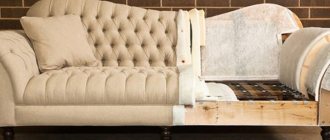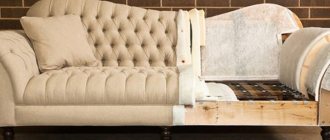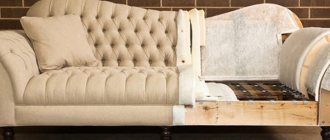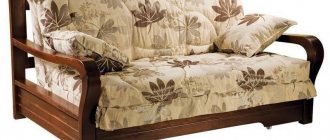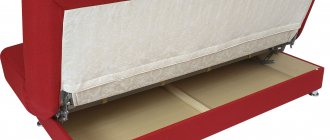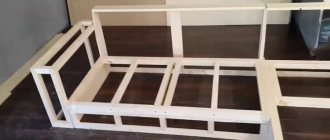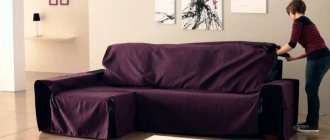Over time, the upholstery of the sofa becomes dirty, stains that cannot be removed appear, as well as holes that cannot be sewn up. This process accelerates if there are small children in the house. Furniture is no longer an interior decoration, and the owners prefer to take it to the dacha or throw it in a landfill. But not everyone has the opportunity to buy a new one every time it gets dirty. In this case, you can do the constriction yourself. To reupholster a sofa with your own hands, you need to know the step-by-step steps.
The benefits of reupholstering a sofa yourself
Restoring furniture with your own hands has a number of advantages:
- Choose any material you like.
- Possibility to repair the frame and springs if necessary.
- Saving money.
In addition, old pieces of furniture are much stronger and more well made than modern ones. Restoration allows you to use the sofa for a long time.
It is not recommended to reupholster the sofa yourself in the following situations:
- The design of the sofa has a complex mechanism that is not easy to disassemble.
- It is difficult to make a pattern for individual parts that have elements of complex geometry.
- The seat has been in use for more than 10 years. In this case, it is impossible to do without repairing the frame and replacing the filler.
- The sofa is an antique and requires careful handling.
- Leather or leatherette is used as upholstery material. Problems may arise when working with them.
In all other cases, you can reupholster furniture at home.
There is a huge selection of materials for upholstering sofas, the main thing is to choose the one that suits you
VIDEO: How to change the upholstery of a sofa with your own hands.
If you have an old sofa at home, the appearance of which leaves much to be desired, it is not at all necessary to get rid of it. Try reupholstering good-quality furniture with a well-functioning folding mechanism, giving it a modern look. With the usual set of tools available in the arsenal of a thrifty owner, this is not difficult to do.
Material selection
First of all, you need to decide what fabric will be used for the upholstery. The table describes the advantages and disadvantages of each material.
| Material | Advantages | Flaws |
| Genuine Leather |
|
|
| Cotton |
| wrinkles and wears out quickly |
| Jacquard |
| quite expensive |
| Flock |
|
|
| Tapestry | adds sophistication to furniture |
|
| Velours |
| wipes quickly |
| Chenille |
|
|
| Arpatek |
|
|
It is recommended to avoid synthetic and rough fabrics. You should not buy material with a strong odor; this is a sign of the use of toxic and low-quality dyes.
Deciding on the design
To change the appearance of an old sofa, you can sew a new cover, make pillows and throws of various models. The furniture will sparkle with new colors. If reupholstery is required, it can be done partially by replacing some upholstery elements. There are many varieties here - from typical to creative.
It is important that everything is in harmony.
A cape made using the patchwork technique will look extraordinary. You can make an unusual applique and glue it to the upholstery. Denim or faux leather is suitable for upholstering a sofa. The most commonly used furniture tapestry, high-quality leatherette, leather, special synthetic velor, artificial fur with a strong base, and furniture jacquard. It is quite possible to sew removable covers from clothing fabrics.
If the sofa is not intended for decoration, but for relaxation of all family members, then you will need strong upholstery that will last for quite a long time.
How much material to buy
After the material has been selected, it is necessary to calculate how much of it to purchase. The easiest way to calculate the amount of fabric is to add the length and width of the sofa. Double the resulting amount. For example, a sofa measuring 2.5 x 1.8. In this case, you need to purchase about 7 meters.
To make the calculation as correctly as possible, it is recommended to adhere to the following instructions:
- Take accurate measurements of all elements of the sofa. In this case, you need to measure the longest and widest parts of the back, seat, armrests and pillows, adding a few centimeters for seam allowances.
- Draw a diagram of the sofa, be sure to ensure that the parts are positioned correctly.
- Add all vertical values and divide by 100. The resulting value is approximately equal to the required length of fabric in meters.
- To determine the width of a piece of fabric, you need to take the widest part from the horizontal piece.
- For a more comfortable cut, it is recommended to add 1 meter for every 5 meters to the resulting length and width.
The approximate material consumption depends on the type of sofa:
- 2-seater - about 10-14 sq. m;
- 3-seater - up to 15 sq.m. m;
- kitchen corner - up to 6 sq. m;
- corner sofa - about 22 sq. m.
Material consumption increases if a complex pattern is applied to the fabric, which must be selected when connecting elements of the sofa, in the absence of a project and pattern.
Step-by-step instruction
To reupholster the backs and seat of a sofa with your own hands, you need to:
- Disassemble the soft part into individual elements.
- Remove upholstery and repair necessary parts.
- Cut out a new one.
- Fasten the fabric.
- Collect all the parts.
Each of the points has its own characteristics.
Stage 1
Disassembling the soft part is much easier than then reassembling it correctly. Therefore, it is recommended to perform all actions slowly and carefully. You can record the whole process on video:
- Detach the sides.
- If there is a seat and backrests, remove them.
Modern upholstered furniture is produced taking into account high maintainability, so this stage does not cause difficulties.
It is advisable to put all fasteners (nuts, screws, bolts) in one place so as not to lose them, since they will be useful during assembly
Stage 2
At this stage the following actions are performed:
- Worn fabric must be removed carefully and slowly, as it will be needed when cutting new material.
- Pull out the fastening brackets carefully so as not to damage the old upholstery.
- It is recommended to check and, if necessary, repair metal parts, springs, and filler. If you neglect this, then in the future they may cause new upholstery defects.
The internal cavities should be cleared of dust and debris.
Stage 3
A high-quality result can only be achieved if the parts are cut correctly. To do this you need:
- Place the new material on a flat horizontal surface.
- Use chalk to outline the elements of the previous upholstery, adding 3-4 cm on each side for hems.
- Cut out the parts strictly along the marked lines.
Patterning the parts is the most important stage in reupholstering a sofa.
Stage 4
In order to secure the new fabric, you need to do the following:
- Apply the prepared patterns to the details of the sofa.
- Stretch the fabric evenly, tucking the edges, otherwise the material will puff up and look sloppy.
- Initially secure with several staples from a furniture stapler.
- Use construction staples or special nails to secure the fabric at a distance of 3-4 cm.
Stage 5
It is recommended to inspect all updated parts before assembly. Then assemble the elements in reverse order.
Repair and replacement of spring block
Repair of the spring unit can be carried out by servicing the existing one or installing a new one. In the first case, the metal is cleaned of rust and lubricated. Then the fixation points are strengthened and the quality of the work performed is checked.
It is somewhat more difficult to carry out a replacement, since you will have to perform a lot of manipulations to fit and fasten the elements.
New springs must be installed in the following sequence:
- Carry out markings. Designate a place for all fragments.
- Attach the springs to the base at three points each. This should be done with twisted wire or rigid tapes.
- Connect the parts together. For this, jute is used, wrapped around the full top turn. First, the binding must be done in one direction, and then across.
Andrey Peregubsky
Furniture handyman
Ask a Question
Now the spring block has become solid and can last for many more decades. Steel is more durable than filler; every time you replace it, you need to clean the coils of rust and generously coat the springs with silicone grease. This material is odorless and stays on the surface for a long time without evaporating or changing its protective characteristics.
Armrest reupholstery
Armrests are the most dirty and vulnerable place. Repairing them will be inexpensive and time-consuming, since you do not need to disassemble the entire sofa. As a new material, it is recommended to choose eco-leather, genuine leather or any other dense fabric that matches the upholstery of the main part.
You should pay attention to the shape of the armrest. If there are bends, you should try to repeat them when attaching new fabric. If this is difficult to do, it is recommended to contact a specialist.
In simpler cases, to tighten the armrests of the sofa with your own hands, you need to follow the instructions step by step:
- Remove the armrests.
- Use a knife, screwdriver or anti-stapler to remove the old upholstery. It is important not to damage it in order to use it as a pattern.
- Using a furniture stapler, attach the new fabric to the armrest, paying attention to the location of the pattern in relation to the upholstery of the back and seats.
- Check the tension level. The fabric should be tightly stretched.
- Attach the armrest in place.
Design features of the book mechanism
Book mechanisms come in two types: with a shelf and without a shelf. They are built the same, but how are they different? What does this even mean, what “shelves”?
A shelf or corner is an additional reinforcement that takes on most of the load. This corner is located at the junction of the mechanism with the frame of the sofa. Increases the strength of the frame, since there is no need to drill through holes in it.
A mechanism without a shelf or without a corner has a flat design, and for attachment to the frame it is necessary to make through holes, which, of course, does not add strength to it. Conclusion: choose sofas with a shelf.
Newbie mistakes
The most common mistake is incorrect calculation of the required amount of material. When purchasing it, you need to consider hems, seams and hems. It is better to buy fabric with a reserve, and if there is excess left, then sew decorative pillows. In the worst case scenario, the store may run out of this material, or the new batch will have a different shade. Experienced professionals give the following advice:
- Before starting work, make sure you have all the necessary tools.
- When reupholstering, it is recommended to use padding polyester, which is laid on foam rubber. Thanks to it, the fabric will stretch better, and during operation it will not come into contact with the foam rubber, which increases the service life of the sofa.
- It is recommended to film or photograph each action during the disassembly process. This will help during assembly.
If you haven’t had to pull up sofas before, it is recommended to first practice on a stool.
It is not difficult to reupholster a sofa at home. You just need to choose the right material and prepare all the necessary tools. The result is an updated piece of furniture that will serve for many years to come.
Required Tools
We have chosen the fabric - it must be taken with a margin for the possibility of error, now we will prepare the tools that will be needed: a sewing machine, a set of needles, strong threads (polyester), a flat-head screwdriver, a hammer, an anti-stapler to remove old staples, pliers, wrenches (from 8 up to 19 mm), side cutters, furniture stapler, scissors, staples (6-8 mm), sewing meter, square, metal ruler, chalk, screwdriver, drill, glue.
The necessary set of tools.

